We are pleased to announce these book publications by members of the ACMS.
When a book has more that one author, the ACMS members will be listed in bold. Any member who would like to have a recent book of theirs advertised on the site is welcome to contact the webmaster.
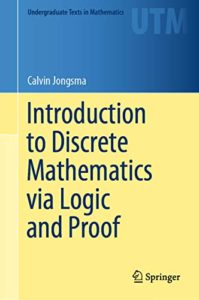
Introduction to Discrete Mathematics via Logic and Proof by Calvin Jongsma (Dordt University) publ. Springer International Publishing
This textbook introduces discrete mathematics by emphasizing the importance of reading and writing proofs. Because it begins by carefully establishing a familiarity with mathematical logic and proof, this approach suits not only a discrete mathematics course, but can also function as a transition to proof. Its unique, deductive perspective on mathematical logic provides students with the tools to more deeply understand mathematical methodology—an approach that the author has successfully classroom tested for decades.
Chapters are helpfully organized so that, as they escalate in complexity, their underlying connections are easily identifiable. Mathematical logic and proofs are first introduced before moving onto more complex topics in discrete mathematics. Introduction to Discrete Mathematics via Logic and Proof will suit intermediate undergraduates majoring in mathematics, computer science, engineering, and related subjects with no formal prerequisites beyond a background in secondary mathematics.
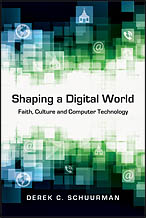 Shaping a Digital World: Faith, Culture and Computer Technology By Derek C. Schuurman (Redeemer University College), publ. InterVarsity Press, (2013).
Shaping a Digital World: Faith, Culture and Computer Technology By Derek C. Schuurman (Redeemer University College), publ. InterVarsity Press, (2013).
Digital technology has become a ubiquitous feature of modern life. Our increasingly fast-paced world seems more and more remote from the world narrated in Scripture. But despite its pervasiveness, there remains a dearth of theological reflection about computer technology and what it means to live as a faithful Christian in a digitally-saturated society.
In this thoughtful and timely book, Derek Schuurman provides a brief theology of technology, rooted in the Reformed tradition and oriented around the grand themes of creation, fall, redemption and new creation. He combines a concise, accessible style with penetrating cultural and theological analysis. Building on the work of Jacques Ellul, Marshall McLuhan and Neil Postman, and drawing from a wide range of Reformed thinkers, Schuurman situates computer technology within the big picture of the biblical story.
Technology is not neutral, but neither is there an exclusively “Christian” form of technological production and use. Instead, Schuurman guides us to see the digital world as part of God’s good creation, fallen yet redeemable according to the law of God. Responsibly used, technology can become an integral part of God’s shalom for the earth.
Companion website for instructors and students.
Complex Analysis for Mathematics and Engineering, 6th ed. by John H. Mathews (California State University) and Russell W. Howell (Westmont College), publ. Jones & Bartlett Learning, (2011).
by John H. Mathews (California State University) and Russell W. Howell (Westmont College), publ. Jones & Bartlett Learning, (2011).
Intended for the undergraduate student majoring in mathematics, physics or engineering, the Sixth Edition of Complex Analysis for Mathematics and Engineering continues to provide a comprehensive, student-friendly presentation of this interesting area of mathematics. The authors strike a balance between the pure and applied aspects of the subject, and present concepts in a clear writing style that is appropriate for students at the junior/senior level.
Through its thorough, accessible presentation and numerous applications, the sixth edition of this classic text allows students to work through even the most difficult proofs with ease. New exercise sets help students test their understanding of the material at hand and assess their progress through the course. Additional Mathematica and Maple exercises, as well as a student study guide are also available online.
 MATH for Liberal Arts by Karl Smith (Santa Rosa Junior College), publ. Cengage: Brooks/Cole, (2011).
MATH for Liberal Arts by Karl Smith (Santa Rosa Junior College), publ. Cengage: Brooks/Cole, (2011).
Designed for and by today’s students in every detail, MATH was developed from over 120 interviews with students and faculty members to provide a more engaging and accessible solution that appeals to different learning styles at a value-based price. MATH presents concepts in a visual and approachable way, ideal for combating the math anxiety often found in Liberal Arts Math students.
Revolutions of Geometry by Michael O’Leary (College of DuPage), publ. Wiley, (2010).
by Michael O’Leary (College of DuPage), publ. Wiley, (2010).
Based on the premise that in order to write proofs, one needs to read finished proofs as well as study both their logic and grammar, Revolutions in Geometry depicts how to write basic proofs in various fields of geometry. This accessible text for junior and senior undergraduates explains the general development of geometry throughout time, discusses the involvement of its major contributors, and places the proofs into the context of geometry’s history to illustrate how crucial proof writing is to the job of a mathematician.
Calculus by Bill Briggs (University of Colorado at Denver) and Lyle Cochran(Whitworth University), publ. Pearson, (2010).
by Bill Briggs (University of Colorado at Denver) and Lyle Cochran(Whitworth University), publ. Pearson, (2010).
Drawing on their decades of teaching experience, William Briggs and Lyle Cochran have created a calculus text that carries the teacher’s voice beyond the classroom. That voice—evident in the narrative, the figures, and the questions interspersed in the narrative—is a master teacher leading students to deeper levels of understanding. The authors appeal to students’ geometric intuition to introduce fundamental concepts and lay the foundation for the more rigorous development that follows. Comprehensive exercise sets have received praise for their creativity, quality, and scope.
Methods for Euclidean Geometry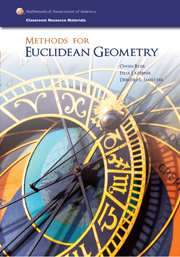 by Owen Byer (Eastern Mennonite University), Felix Lazebnik (University of Delaware), and Deirdre Smeltzer(Eastern Mennonite University), publ. MAA, (2010).
by Owen Byer (Eastern Mennonite University), Felix Lazebnik (University of Delaware), and Deirdre Smeltzer(Eastern Mennonite University), publ. MAA, (2010).
Euclidean plane geometry is one of the oldest and most beautiful topics in mathematics. Instead of carefully building geometries from axiom sets, this book uses a wealth of methods to solve problems in Euclidean geometry. Many of these methods arose where existing techniques proved inadequate. In several cases, the new ideas used in solving specific problems later developed into independent areas of mathematics. This book is primarily a geometry textbook, but studying geometry in this way will also develop students’ appreciation of the subject and of mathematics as a whole. For instance, despite the fact that the analytic method has been part of mathematics for four centuries, it is rarely a tool a student considers using when faced with a geometry problem. Methods for Euclidean Geometry explores the application of a broad range of mathematical topics to the solution of Euclidean problems.
 Differential Geometry of Manifolds by Stephen Lovett (Wheaton College), publ. A. K. Peters, Ltd., (2010).
Differential Geometry of Manifolds by Stephen Lovett (Wheaton College), publ. A. K. Peters, Ltd., (2010).
Intended for upper undergraduate or beginning graduate students, this book introduces students to the modern theory of manifolds. Assuming a basic knowledge of the differential geometry of curves and surfaces the focus is on differentiable manifolds and the study of Riemannian manifolds. The book concludes with applications of manifolds to physics. Exercises at the end of each section and appendices on topology and linear algebra make this book ideal for self-study or as a textbook.
Voltaire’s Riddle by Andy Simoson (King College), publ. MAA Press, (2010).
by Andy Simoson (King College), publ. MAA Press, (2010).
Did you know that Voltaire was the first to publish the legend of Isaac Newton discovering gravity upon seeing an apple fall? That he tried for about eight years to be a mathematician? This book is about Voltaire’s story, Micromegas and its underlying mathematics.
A Window into Zeta and Modular Physics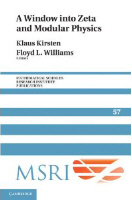 edited by Klaus Kirsten (Baylor University) and Floyd L. Williams (University of Massachusetts, Amherst).
edited by Klaus Kirsten (Baylor University) and Floyd L. Williams (University of Massachusetts, Amherst).
This book provides an introduction to (1) various zeta functions (for example, Riemann, Hurwitz, Barnes, Epstein, Selberg, and Ruelle), including graph zeta functions; (2) modular forms (Eisenstein series, Hecke and Dirichlet L-functions, Ramanujan’s tau function, and cusp forms); and (3) vertex operator algebras (correlation functions, quasimodular forms, modular invariance, rationality, and some current research topics including higher genus conformal field theory). Various concrete applications of the material to physics are presented. These include Kaluza-Klein extra dimensional gravity, Bosonic string calculations, an abstract Cardy formula for black hole entropy, Patterson-Selberg zeta function expression of one-loop quantum field and gravity partition functions, Casimir energy calculations, atomic Schrödinger operators, Bose-Einstein condensation, heat kernel asymptotics, random matrices, quantum chaos, elliptic and theta function solutions of Einstein’s equations, a soliton-black hole connection in two-dimensional gravity, and conformal field theory.
Differential Geometry of Curves and Surfaces by Thomas Banchoff (Brown University) and Stephen Lovett (Wheaton College), publ. A. K. Peters, Ltd., (2010).
by Thomas Banchoff (Brown University) and Stephen Lovett (Wheaton College), publ. A. K. Peters, Ltd., (2010).
This textbook is intended for a one-semester undergraduate course in the differential geometry of curves and surfaces, assuming only multivariable calculus and linear algebra. The book culminates with the celebrated Gauss-Bonnet Theorem and applications to spherical and hyperbolic geometry. Online interactive computer graphics applets coordinated with each section allow teachers and students to investigate and manipulate curves and surfaces to develop intuition and to help analyze geometric phenomena.
The Moore Method: A Pathway to Learner-Centered Instruction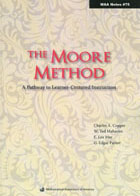 by Charles A. Coppin (Lamar Univesity), W. Ted Mahavier (Lamar University), E. Lee May (Salisbury University), and G. Edgar Parker (James Madison University), publ. MAA, (2009).
by Charles A. Coppin (Lamar Univesity), W. Ted Mahavier (Lamar University), E. Lee May (Salisbury University), and G. Edgar Parker (James Madison University), publ. MAA, (2009).
The Moore Method: A Pathway to Learner-Centered Instruction offers a practical overview of the method as practiced by the four co-authors, serving as both a how to manual for implementing the method and an answer to the question, what is the Moore method?. Moore is well known as creator of The Moore Method (no textbooks, no lectures, no conferring) in which there is a current and growing revival of interest and modified application under inquiry-based learning projects. Beginning with Moore’s Method as practiced by Moore himself, the authors proceed to present their own broader definitions of the method before addressing specific details and mechanics of their individual implementations. Each chapter consists of four essays, one by each author, introduced with the commonality of the authors’ writings.
Topics include the culture the authors strive to establish in the classroom, their grading methods, the development of materials and typical days in the classroom. Appendices include sample tests, sample notes, and diaries of individual courses. With more than 130 references supporting the themes of the book the work provides ample additional reading supporting the transition to learner-centered methods of instruction.
Curious Curves by Richard Darst (Colorado State University), Judith Palagallo(The University of Akron), and Thomas E. Price (The University of Akron), publ. World Scientific, (2009).
by Richard Darst (Colorado State University), Judith Palagallo(The University of Akron), and Thomas E. Price (The University of Akron), publ. World Scientific, (2009).
Curious Curves is self-contained and unified in presentation. This book is suitable for a topics course, capstone course, or senior seminar; it is also intended for independent study by students and others interested in mathematics.
Curves can often provide a better representation of natural phenomena than do the figures of classical geometry. Thus the content — presented with an emphasis on the geometric intuition characteristic of the study of curves — is highly relevant not only for people working in mathematics, but also those in other sciences. The explanations are detailed and illustrative to capture the interest of the reader, as well as complete to provide the necessary background information needed to go further into the subject.
Supplemental Mathematics for the Curious: Number Systems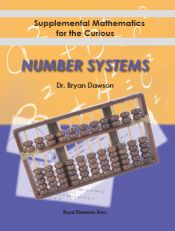 by Bryan Dawson (Union University), publ. Royal Fireworks Press.
by Bryan Dawson (Union University), publ. Royal Fireworks Press.
Designed for the self-learner who has completed the traditional high school mathematics curriculum through trigonometry, this supplemental text is ideal for summertime or other independent study. Beginning with new ways to think about such familiar number systems as natural and rational numbers, the text progresses through algebraic numbers, real numbers, complex numbers, quaternions and infinitesimals.
Supplemental Mathematics for the Curious: Number Theory by Bryan Dawson(Union University), publ. Royal Fireworks Press.
by Bryan Dawson(Union University), publ. Royal Fireworks Press.
Designed for the gifted self-learner who has completed Algebra I, this supplemental high school text is ideal for summertime or other independent study. The topics chosen form an introduction to the rich field of number theory. Among others, they include: divisibility, the Euclidean algorithm, prime numbers, figurate numbers, recursively-defined numbers such as Fibonacci and Lucas numbers.
Christian Humanist Foundations for Statistical Inference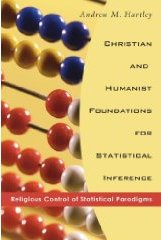 by Andrew Hartley(PPDI – Pharmaceutical Product Development, Inc.) publ. Resource Publications, (2007).
by Andrew Hartley(PPDI – Pharmaceutical Product Development, Inc.) publ. Resource Publications, (2007).